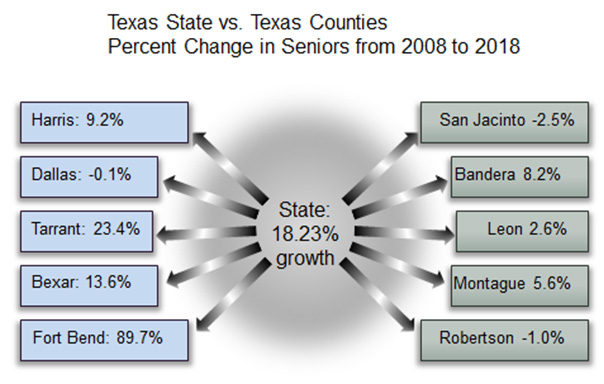enrollment
Using county-level high school enrollment projections to size your college enrollment market
Where do you want your campus enrollment to be five years from now? Ten years from now?
Whatever your answers to those questions might be, you have to take into consideration the sizes of upcoming high school senior classes in your target markets and what percentage of those markets you can expect to capture. The difficult news, however, is that for more than half of the states in the US, the number of high school graduates is projected to decline in the coming years. (See Knocking at the College Door from the Western Interstate Commission for Higher Education for projections to 2022.)
These changes will likely lead to greater competition for students. Your traditional markets may shift dramatically as demographic shifts and increased competition alter the supply of students. Even if you only hope to maintain your current enrollment levels, you will need to be more strategic and precise in understanding where your potential student pools exist.
One initial step that campuses can use is the projection of high school enrollment numbers at the county level. Whether states are projected to decline or increase in the number of high school graduates, not all of these changes will be spread evenly throughout the state. Furthermore, most colleges and universities don’t draw students from entire states, but rather from specific regions within their state or neighboring states. Consider one of the projected growth states, Texas, and how much these projections vary from one county to another:

With existing enrollment data in hand, your campus can see trends in enrollment and use this data to make enrollment projections. This gives campuses a much more detailed understanding of where the shifts are occurring in a given state.
Projecting high school senior enrollments using the Weighted Average Cohort Survival Rate
In order to start making projections, you first need public and private school enrollment data for kindergarten through twelfth grade for the past five years. This data is available from the National Center for Education Statistics:
- Public high school enrollments: the annual Common Core Data (CCD) survey results
- Private school enrollments: the Private Schools and Staffing (PSS) survey, conducted every other year
Next, you need to need to calculate the Weighted Average Cohort Survival Rate (WACSR) for each grade level and for each of the past five years that have enrollment data . Use the following to calculate the Cohort Survival Rate (CSR) for one year:
Number of current students in grade 12 ÷ number of students in grade 11
during the previous year = CSR
To calculate the Weighted Average Cohort Survival Rate, you’ll want to use a five-year average for the CSR with the most recent year weighted more heavily. At Noel-Levitz, we use the same methodology that WICHE uses:
40% of the current CSR + 15% of the CSR for each of the previous four years = WACSR
Finally, to make a prediction on the next senior class, simply take the current junior class and multiply that enrollment to the CSR average for the county you are projecting:
Current junior class x five-year CSR average for junior-to-senior =
next year’s senior class
This can be used to project classes up to 10 years into the future. This method can also be used to calculate projections for subpopulations of students such as males/females and specific ethnic groups. It is particularly useful for campuses in areas seeing changes in demographics.
How county-level projections benefit campus enrollment management
This method offers several benefits to campuses.
- Identify regions to target for recruitment activities. Not only can county-level projections reveal very specific overall growth estimates of college seniors, they can reveal pockets of student subpopulations. If your campus is trying to increase diversity, this strategy could help determine where to focus your recruitment.
- Target travel more precisely. This is especially valuable for campuses that have to cover large geographic areas for recruitment.
- Target list purchases and mailings more strategically. As with travel, knowing where you should be mailing and focusing contact efforts can save a great deal of money and effort.
County-level projections are by no means a magic bullet or a foolproof method. This approach is most valuable to campuses whose college-bound high school enrollments come from specific regions in their state or neighboring states. A campus will also need to know how many college-bound students it enrolls from each county in order to maximize the accuracy of the projections. If a state makes an effort to increase college participation or attract more nontraditional students, this method could underestimate the future size of the college population since it focuses on projecting college-bound high school students.
However, county-level high school enrollment projections illustrate how data can be used strategically and creatively to inform enrollment strategies. Used properly, they can provide very valuable information for focusing recruitment efforts among campuses who wish to either maintain or grow their market share.
Is the county-level projection method a strong strategy for your campus? Send me an e-mail and we can discuss your specific details and see how much this approach could benefit your enrollment management.